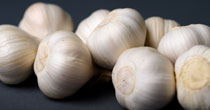Healthy Garlic
Copyright © 2008
by Joe Smulevitz, CH, MH

Garlic is one of the best examples of an age-old medicinal plant that is still one of the most effective herbs for the major diseases of our time. The hardy, pungent-flavoured bulb is made up of several “cloves” that are used as a valuable food, seasoning, and medicinal product. Garlic originated in Central Asia but is now cultivated worldwide, although it does not flourish in very cold climates. The plant belongs to the Allium family, which also includes onions, leeks, shallots, and chives. Of these, garlic contains the most powerful sulphur-containing compounds that are largely responsible for its health-protective benefits.
Records validating garlic use go back thousands of years. It was highly prized in ancient Egypt, Rome, Greece, and China. Egyptian slaves ate garlic to keep themselves healthy as they built the great pyramids. The Romans used garlic to strengthen themselves in battle. The Greeks believed the herb would heal their wounds and bring strength to their athletes at the Olympic games. Ancient Chinese herbalists used garlic for treating colds, tuberculosis, respiratory problems, and for its beneficial effects on circulation and the heart. Before the advent of antibiotics, garlic was renowned for treating infections. In both World Wars it was used in hospitals and on the battleground as an antiseptic to disinfect wounds and prevent gangrene.
So where does this leave us today? Since the 1960s, extensive laboratory and clinical research has made garlic one of the most intensively studied herbs in natural medicine. A growing body of evidence shows that the sulphur-containing constituents have cardio protective, anti-microbial, and potentially anti-cancer actions.
Volumes of research have documented the cardiovascular benefits of garlic’s ability to modestly lower blood cholesterol. Although not every study has found garlic lowers cholesterol, most studies have. The heart healthy bulb is also touted for its ability to inhibit and reverse the build up of arterial plaque. Countless studies have identified garlic’s anti-microbial activity against many species of bacteria, viruses, worms, and fungi. The findings support the historical use of garlic in treating infections. Numerous studies have shown that a high consumption of garlic may reduce the incidence of certain cancers, particularly of the gastrointestinal tract.
In an exciting study just completed, from the Medical University of South Carolina, researchers found that garlic may kill the cells that cause glioblastoma, a fatal brain cancer. Another recent study from the University of Alabama in Birmingham suggests that eating garlic may lead to relaxation of blood vessels, thus lowering high blood pressure.
The best way to obtain the potent health-promoting effect of garlic is by eating one or more raw cloves daily. Scientists suggest cutting and peeling a fresh piece of garlic and letting it sit for 15 minutes before eating or cooking it. This allows time for the chemical allicin, purported to be the phytochemical that provides garlic’s strong aroma and many of the therapeutic health benefits, to develop.
The distinctive aroma garlic leaves on the breath and even on the skin, encourages garlic consumption in the form of odour-controlled or odourless commercial products. Unfortunately, the quality of preparations can be highly variable. The best garlic products closely resemble the eating of raw garlic. Therefore, it is important to use only high quality preparations that yield a high level of allicin.
Products that are standardized (guarantees the level of one or more of the main active ingredients) for allicin content provide the greatest assurance of quality. Ideally, each tablet should contain 5,000 micrograms of allicin, which equals approximately 1 fresh clove of garlic.
Check with your physician if using blood-thinning medications (aspirin, warfarin, and nonsteroidal anti-inflammatory drugs such as ibuprofen) before taking garlic supplements. Garlic’s anti-clotting properties may increase the risk of bleeding.
Joe Smulevitz is a Chartered Herbalist, a Master Herbalist, a nutritional researcher, and author of numerous health articles. He can be reached at herbalistjoe@sympatico.ca.
|
